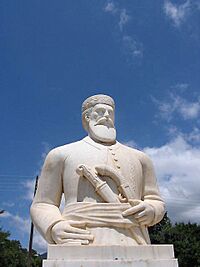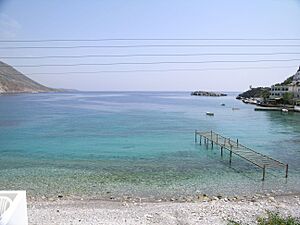Daskalogiannis facts for kids
Quick facts for kids
Ioannis Vlachos
|
|
|---|---|
 |
|
| Native name |
Ιωάννης Βλάχος
|
| Nickname(s) |
|
| Born | 1722 or 1730 Anopolis, Crete, Ottoman Empire |
| Died | 17 June 1771 (age 40–49) Heraklion, Crete, Ottoman Empire |
Ioannis Vlachos (Greek: Ιωάννης Βλάχος), also known as Daskalogiannis (Δασκαλογιάννης; born 1722/30 – died 17 June 1771), was a rich shipbuilder and shipowner. He led a revolt in Crete against the Ottoman Empire in the 1700s.
Contents
Who was Daskalogiannis?
Ioannis Vlachos was born in a village called Anopolis in Sfakia, Crete. Sfakia was a special region that had some freedom from the Ottoman Empire. He was born in either 1722 or 1730. His father was also a wealthy shipowner and sent him to study abroad. Because of his good education, people called him "Daskalos" (which means teacher). That's how he got his nickname Daskalogiannis, meaning "John the Teacher."
By 1750, he was working as a town clerk. In 1765, he became the chairman of the Sfakia region. He owned four large merchant ships with three masts. These ships would sail from places like Omprosgialos and the gulf of Loutro.
Daskalogiannis knew a person named Panagiotis Benakis from Mani. Benakis likely introduced him to Count Orlov. Count Orlov was sent by Catherine the Great, the Empress of Russia, to the Peloponnese in 1769. His job was to start a rebellion there. Many men from Sfakia also joined this rebellion in the Peloponnese.
Leading the Cretan Revolt
In early 1770, Daskalogiannis was contacted by people from Russia. They wanted to encourage the Greek people living under Ottoman rule to rebel. Daskalogiannis agreed to help pay for and organize a rebellion in Sfakia. The Russian messengers promised to support him.
In the spring of 1770, Daskalogiannis got ready for the revolt. He gathered men, rifles, and supplies. He also built defenses in important places. However, the Russian navy, led by Count Orlov, did not come to Crete. This meant the revolt had to rely only on its own strength.
The uprising began on March 25, 1770. The rebels attacked areas like Kydonia, Apokoronas, and Agios Vasilios. At first, the rebels made the Ottoman soldiers run away. Parts of Crete even seemed like an independent country. They even made their own coins in a cave near Hora Sfakion.
But soon, the Ottoman forces gathered their troops again. By May, they had a large army of 40,000 men ready at the village of Vrysses.
The Battle and its Aftermath
When the Ottoman army attacked Daskalogiannis and his men on the Krapi plateau, the rebels lost badly. They had to hide in the high mountains. The Ottoman forces kept the rebels trapped. They also destroyed many villages in the area. They scattered the sheep, stole from the province, and captured many people. These captured people were then sold in the slave market in Chándakas (now Heraklion). Daskalogiannis's uncle was also taken prisoner.
The promised help from Russia never arrived, and the uprising did not spread to other parts of Crete. On March 18, 1771, the Ottoman forces gave the rebels an ultimatum. This meant they had a final offer. If they surrendered, they would be safe. But this offer came with a list of peace terms.
Terms of Surrender
The document had 12 main points:
- They had to pay the taxes they had refused to pay the year before.
- They had to give up their weapons and supplies.
- They had to surrender their leaders, who would go to Iraklion for legal actions.
- They could no longer contact or supply Christian ships in their harbors.
- They had to help arrest the crews of Christian ships and take them to Iraklion.
- Justice in Sfakia would be managed by a judge chosen by the Ottoman government.
- Churches could not be repaired or built new.
- They had to pay a tithe (a type of tax) as ordered by the Sultan.
- No tall houses (like castle towers) could be built, and no Christian symbols were allowed on buildings.
- Religious celebrations and bell ringing were forbidden.
- Captured Muslims had to be released.
- The Sfakiots had to wear specific clothes for people under Ottoman rule.
When Daskalogiannis realized the battle was lost, he surrendered to the Ottoman forces. He hoped this would make things easier for his people. It is also said that his brother, Nikolós Sgouromállis, who was already captured, was forced to write him a letter. This letter claimed the Ottoman forces would be kind.
Daskalogiannis was taken to Iraklion with his most trusted men. However, the pasha (governor) of the town did not keep the promise of the ultimatum. Instead, Daskalogiannis was executed in a harsh way on June 17, 1771. He faced this ordeal in complete silence.
Daskalogiannis's Family
Daskalogiannis was married to Sgouromallini. Their daughters, Anthousa and Maria, fought alongside their father during the revolt. Sadly, Sgouromallini and Anthousa were killed after the revolt ended. Maria was captured and became a slave. She was given to an Ottoman vizier (a high official). He then gave her to the teftedar (a financial officer) of Heraklion.
The teftedar married Maria. He did not force her to change her religion to Islam, which was unusual for that time. They moved to Constantinople. After her husband died in 1816, Maria inherited a lot of money. She later gave this money to the Greek revolutionaries when the Greek War of Independence began.
Daskalogiannis's Legacy
Daskalogiannis is remembered in many folk tales and songs. One of the most famous is an epic ballad from 1786 by Barba-Pantzelios, a cheese-maker. It's called To tragoudi tou Daskalogianni (The Song of Daskalogiannis):
- …Φτάνουν στο Φραγκοκάστελο και στον πασά ποσώνου,
- κι εκείνος δούδει τ' όρντινο κι ευτύς τσοι ξαρματώνου.
- Ούλους τσοι ξαρματώσασι και τσοι μπισταγκωνίζου
- και τότες δα το νιώσασι πως δεν ξαναγυρίζου.
- ...They arrive at Frangokastello and surrender to the pasha,
- and he gives the order to disarm them at once.
- All of them were disarmed and ill at ease,
- for now they sensed that they would never go home.
People say that before Daskalogiannis and his few men made their final stand against the Ottoman forces, they danced the war dance called Pentozalis.
Today, the Chania International Airport in Chania is named after Daskalogiannis. You can also see a statue honoring him in his hometown of Anopolis. One of the ferries that travels the Crete southeast routes is also named the Daskalogiannis.


